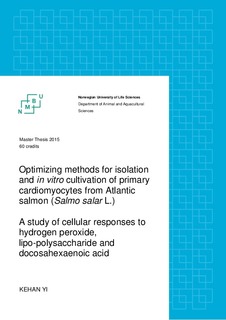| dc.description.abstract | Atlantic salmon (Salmo salar L.) has been the most produced species in Norway. However, production related losses remain significant recent years, and a large proportion of this were due to viral diseases. Among these diseases, PD, HSMI, and CMS, commonly affect the heart of farmed salmon. Therefore, the primary goal of this work was to establish a salmon cardiomyocyte culture system that enabling us to carry out further studies on how salmon cardiomyocytes react to different stimulus.
In the first study, we tested two different isolation methods with two different cell culture media, the combination of collagenase and trypsin was proven to be the better one in cell isolation than trypsin alone. And then, in the time study, heart cells were harvested at day 2, 3, 5, 7, 9, 11, respectively to analyze the expression level of several gene markers, the significantly increased expression of PCNA, CAV3, and GATA4 indicates that primary cultured salmon cardiomyocytes have strong abilities to proliferate and differentiate in vitro. Also, we found that the seeding density is important for good proliferation and development of cardiomyocytes in culture. Besides, to learn the morphological changes of cardiomyocytes in culture with time, cells were cultured up to 60 days, spontaneously beating cell structures were observed during this period, and some of these structures even kept contracting over 5 weeks.
Then, we tried to increase cell proliferation by either adding growth factor to the culture media or improving the coating materials. No positive effect was observed on cell proliferation towards supplementation of 125 ng/mL bFGF, but it seems possible to increase cell yield by improving the coatings, since ECL, fibronectin, and ECM coating all performed better than laminin.
Finally, we studied the stress responses of cardiomyocytes to H2O2 and the effects of DHA on LPS induced immune response. Cardiomyocytes from three experimental groups were incubated with 100 μM H2O2 for 30, 60, and 90 min, respectively. Our results suggest that cardiomyocytes responded to H2O2 by up-regulating SOD1 and GPx-3, and a 30 min incubation may even result in hypertrophic growth in salmon cardiomyocytes. However, no strong immune reaction was observed when we stimulated cardiomyocytes with 100 ng/mL LPS, and salmon cardiomyocytes responded little to DHA as well, only with significantly increased expression of SOD1 among all the gene markers tested. | nb_NO |
